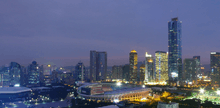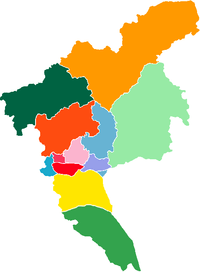Guangdong Olympic Stadium
The Guangdong Olympic Centre Stadium or officially Aoti Main Stadium[4] is a multi-purpose stadium in Guangzhou, People's Republic of China. Currently used mostly for football matches, the stadium was opened in 2001. It has a capacity of 80,012, making it the largest stadium in the country by seating capacity.[5]

| |
| Location | Guangzhou, China |
|---|---|
| Public transit | |
| Owner | Guangdong People's Government |
| Operator | Guangdong Sports Bureau |
| Capacity | 80,012 |
| Surface | Grass |
| Construction | |
| Broke ground | 31 December 1998[1] |
| Built | 1999–2001 |
| Opened | 22 September 2001[2] |
| Construction cost | 1.23 billion RMB |
| Architect | Ellerbe Becket[3] |
| Guangdong Olympic Stadium | |||||||||||
|---|---|---|---|---|---|---|---|---|---|---|---|
| Traditional Chinese | 廣東奧林匹克體育中心 | ||||||||||
| Simplified Chinese | 广东奥林匹克体育中心 | ||||||||||
| |||||||||||
History
Guangdong Olympic Stadium broke ground on 31 December 1998 at the former site of Huangcun Airport.[6] It opened to the public for the Ninth National Games of China in 2001. It was originally planned to help host the 2008 Summer Olympics[7] until a decision was made to construct the National Stadium in Beijing. The original design for the Guangdong Olympic Stadium was announced in 1999. Taking Guangzhou's nickname, the Flower City, the American architectural firm of Ellerbe Becket designed Guangdong Olympic Stadium's sunscreen roof to resemble layers of petals on a flower.[8] The design firm stated in its press release: "The stadium bowl grows out of the ground to a sculpted upper edge, like the petals of a flower. Floating above the bowl is a shimmering ribbon of roof flowing like a wave over the seats. It parts at the ends and holds the Olympic flame, suspended between the two ribbons. A hotel surrounds a circular opening in the roof that forms a vertical tower of light, which at night is visible for a great distance." The stadium's multi-colored seats are positioned in multiple sections that are visually connected via a ribbon pattern.
Major events
- Guangzhou Pharmaceutical F.C. hosted the English Premier League champions Manchester United F.C. here on 27 July 2007.
- Guangzhou Pharmaceutical F.C. hosted Chelsea F.C. on 23 July 2008 in Chelsea's first-ever trip to China.
- The stadium hosted the athletics events of the 2010 Asian Games and 2010 Asian Para Games, as well as the opening and closing ceremonies of the 2010 Asian Para Games. The ceremonies for 2010 Asian Games were held at a stand at Haixinsha Island in the Tianhe District.
References
- "广东省奥林匹克体育中心". Guangdong Sports Bureau. Retrieved 20 January 2016.
- "Chinese Architecture- Guangdong Olympic Stadium". Chinese-architecture.info. Retrieved 2 May 2011.
- Guangdong Olympic Stadium Archived 29 May 2012 at the Wayback Machine architect: Ellerbe Becket
- "Making the Aoti Main Stadium accessible". China Daily. 19 December 2010. Retrieved 19 December 2010.
- "Chinese Architecture- Guangdong Olympic Stadium". Chinese-architecture.info. Retrieved 2 May 2011.
- Zhang, Tristin (8 April 2018). "The Story Behind China's Largest Sports Stadium". That's Mag.
- ArchitectureWeek - Design - China's Banner Stadium - 2002.0501
- "Guangdong Olympic Stadium". Archiplanet. Archived from the original on 26 February 2012. Retrieved 2 May 2011.
External links
| Preceded by Amman International Stadium Amman |
Asian Athletics Championships Venue 2009 |
Succeeded by Kobe Universiade Memorial Stadium |

